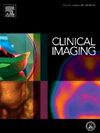A qualitative, community-based needs assessment to inform the development of a radiology health equity curriculum
IF 1.8
4区 医学
Q3 RADIOLOGY, NUCLEAR MEDICINE & MEDICAL IMAGING
引用次数: 0
Abstract
Background
Recognizing barriers to care is crucial for radiologists to ensure equitable access and quality care for all patients. Health equity trainings have shown promising results in helping providers understand unique patient needs.
Purpose
To perform community-based focus groups to gather needs assessment data as the foundation for a health equity curriculum for radiology professionals.
Methods
We conducted focus groups to gather in-depth qualitative data regarding health inequities in radiology. Radiology residents, medical students, and community partners were recruited from two large academic medical centers, three medical schools, three radiology trainee programs, and five community organizations. Focus groups were conducted in-person and virtually from December 2022 to April 2023, recorded, and transcribed. Qualitative analysis with multiple coding of verbatim transcripts was performed by study staff, overseen by a senior analyst.
Results
Study participants included trainees (medical students, n = 19; and radiology residents, n = 6), and community partners (n = 14) across 4 focus groups. Three major themes emerged from our discussions: (1) Awareness of Healthcare Inequities, (2) A Gap Between Knowledge and Practice, and (3) Achieving Equity in Radiology Care. Trainees highlighted current gaps in education while expressing a desire to receive applied learning experiences to prevent gaps from widening. Community partners shared difficult experiences and expressed a desire to be heard.
Conclusion
Health equity training can help future radiologists better understand diverse patient needs. Fostering community partnerships can ensure that the voices of diverse communities guide the development of health equity curricula in radiology.
求助全文
约1分钟内获得全文
求助全文
来源期刊

Clinical Imaging
医学-核医学
CiteScore
4.60
自引率
0.00%
发文量
265
审稿时长
35 days
期刊介绍:
The mission of Clinical Imaging is to publish, in a timely manner, the very best radiology research from the United States and around the world with special attention to the impact of medical imaging on patient care. The journal''s publications cover all imaging modalities, radiology issues related to patients, policy and practice improvements, and clinically-oriented imaging physics and informatics. The journal is a valuable resource for practicing radiologists, radiologists-in-training and other clinicians with an interest in imaging. Papers are carefully peer-reviewed and selected by our experienced subject editors who are leading experts spanning the range of imaging sub-specialties, which include:
-Body Imaging-
Breast Imaging-
Cardiothoracic Imaging-
Imaging Physics and Informatics-
Molecular Imaging and Nuclear Medicine-
Musculoskeletal and Emergency Imaging-
Neuroradiology-
Practice, Policy & Education-
Pediatric Imaging-
Vascular and Interventional Radiology
 求助内容:
求助内容: 应助结果提醒方式:
应助结果提醒方式:


